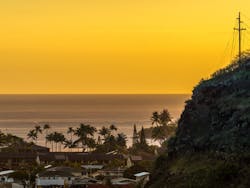Hawaii is traversing new ground as state regulators, its utility and other stakeholders work on what may become the first full microgrid tariff in the United States.
A microgrid tariff may help assure electric reliability in remote areas of Hawaii, as well as other consumer benefits. (Photo by Phillip B. Espinasse/Shutterstock)
The parties filed opening briefs this month before the Hawaii Public Utilities Commission, revealing the complexity of setting microgrid compensation via a utility tariff (Docket No. 2018-0163).
Hawaii is the first state to begin a proceeding to create a tariff to pay microgrid owners and streamline the interconnection process.
California is following close behind, however, with lawmakers in September passing legislation similar to the bill that kick-started Hawaii’s effort. California regulators have yet to take up the issue — the law gives them until December 2020 to act.
Hawaii’s law calls for the PUC to create a tariff to pay for microgrid services. Exactly how much microgrids should receive “is a complicated matter that will require significant analysis,” said Hawaiian Electric Companies (HECO) in its opening brief before the Hawaii Public Utilities Commission.
While it did not attempt to set a specific value at this early stage in the proceeding, the utility did suggest eligibility requirements.
Who should receive microgrid tariffs?
Utilities should not receive the compensation since they already can recover microgrid costs through rates; instead, the tariff should go to “third-party owners,” said HECO, which serves 95 percent of Hawaii’s 1.4 million residents.
The utility also suggested that only grid-connected microgrids receive the compensation, arguing that off-grid microgrids serve only their immediate customers and do not provide broader public benefits.
HECO sees the public benefits emanating from a microgrid’s grid connection. By strengthening the grid, all customers benefit, justifying payment within utility rates to support the tariff.
But many of the services microgrids provide to the grid — such as capacity, demand response, and community renewable energy — already receive payment via other tariffs and programs. HECO argued that microgrids should not receive double compensation.
Join us for a special pre-Microgrid 2019 workshop on microgrid tariffs, incentives and policy May 13 in San Diego.
Instead, the utility wants regulators to focus on microgrid benefits that are not otherwise compensated, particularly resiliency and reliability.
In setting payment, regulators should consider not only what the microgrid provides to the grid, but how the grid serves the microgrid. So microgrids would receive a net payment. Similarly, the state Division of Consumer Advocacy recommended that a separate standby tariff be created that would charge microgrids should they go off line, causing their customers to rely on grid power.
Anyone could own and operate a microgrid, under HECO’s proposal, but the utility said it encourages collaboration between utilities and customers.
“The collaborative teams can determine and coordinate the specific services needed, especially with the rapidly changing environment in the production, delivery and consumption of electricity, caused in large part by the exponential advancements in technology — such as solar, wind, battery storage units, software, and controls,’ said HECO in the filing.
Microgrids would be limited in size under HECO’s proposal — large enough to justify the administrative expense of managing the tariff, but small enough that they don’t require special contracts appropriate for large and complex resources.
The utility says it support microgrids and featured two of its projects, the 50-MW Schofield Generating Station Project, a collaboration between the utility and the Army, and the proposed non-wires alternative in remote North Kohala.
MRC see role for cogen in Hawaii
HECO says microgrids should use all renewable energy — except in emergencies — in keeping with Hawaii’s goal to achieve 100 percent renewables by 2045. The Microgrid Resources Coalition (MRC), however, urged regulators to also consider cogeneration because of its high efficiency, particularly modem facilities fueled with liquified natural gas (LNG).
“LNG-fired cogeneration facilities for large thermal loads such as industrial or medical facilities should be considered to avoid waste heat from thermal only fuel conversion without diminishing the 100 percent RPS [renewable portfolio standard],” said the MRC in its filing.
The organization, an advocacy group that represents microgrid owners, operators, developers, suppliers, and investors, also took issue with creating size limitations for microgrids under the tariff.
“We do not support size limitations. MRC member University of Texas at Austin operates a microgrid with over 100 MWs of capacity,” said MRC, adding that household microgrids with solar, batteries and comparatively simple controls also should not be excluded, although they may be required to operate as part of an aggregation to receive the tariff.
In its brief, the state Division of Consumer Advocacy recommended identification of places in Hawaii where greatest need exists for microgrids, such as hospitals and areas where it’s difficult for utility workers to restore service.
The consumer advocate also questioned whether a microgrid tariff is necessary or just “nice to have.” Other regulatory proceedings underway may “be more practical to encourage and shape the development of microgrids, such as establishing prices that send efficient signals to the market, including the microgrid market” — in particular a docket underway on distributed energy resources (Docket No. 2014-0192).
The commission is requesting reply briefs on the microgrid tariff by March 11. The opening briefs are available on the Hawaii PUC’s website.
Track news about microgrid tariff strategies. Subscribe to the free Microgrid Knowledge newsletter.







